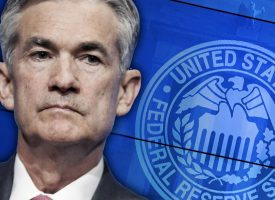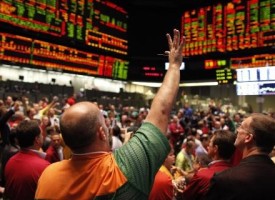Today a legend in the business sent King World News a powerful piece stating that a break of this key level will unleash the gold price to $1,700.
“Hence, a wise general makes a point of foraging on the enemy. One cartload of the enemy’s provisions is equivalent to twenty of one’s own.” — Sun Tzu – the Art of War (5th Century)
1930’s vs Today
By John Ing, Maison Placements
August 4 (King World News) – In essence, if you are going to war, make sure the costs of war is borne by the enemy, not your own people. Instead of saying, “trade wars are good and easy to win”, Mr. Trump would be wise to follow the ancient general’s advice. Winning a trade war is not so easy, history shows that tariffs which are like taxes will hurt his own people in many ways.
And almost 1700 years later, Chinese Commerce Ministry spokesperson Gao Feng said:
“US measures are essentially attacking global supply and value chains. To put it simply, the US is opening fire on the entire world, including itself. China will not bow down in the face of threats and blackmail and will not falter from its determination to defend free trade and the multilateral system.”
The world is changing and rather than a new industrial revolution, we are experiencing a new world disorder as President Trump’s tariff war redesigns postwar geopolitics. Part of it is rooted in the “disrupter-in-chief’s” nostalgic fixation on the glorious ‘60s with his Trumpian nationalistic focus fracturing relationships with America’s closest allies. Unfortunately, Canada and Mexico are to be collateral damage in a trade battle between America and its rival, China where both sides have slapped escalating tariffs worth tens of billions of dollars and threatening worse.
The Second Coming of The Dirty Thirties?
It has happened before. The last time in the ‘80s there was a big protectionist push in the US against Japan but America succumbed when it became apparent that consumers were to be the ones that would be hurt the most. Or, going back further in time, Newton D. Baker, former Secretary of War under Woodrow Wilson, described the passing of the Smoot-Hawley Tariff Act as, “a war declared … against the rest of mankind”. Like then, “beggar thy neighbor” nationalism had its costs and the Great Depression soon followed. And today the parallels are eerily similar to when politicians underestimated risk…
Listen to the greatest Egon von Greyerz audio interview ever
by CLICKING HERE OR ON THE IMAGE BELOW.
Indeed, the Smoot-Hawley Tariff Act enacted in June 1930 was the largest single tax increase averaging 20 percent to 44 percent on 900 imported products. That sparked a massive retaliation by foreigners on American goods. Congress thought the Tariff Act would be a quick fix to the economy by boosting American goods at the expense of imports. President Hoover even reduced taxes. Within thirty days, countries retaliated and global trade collapsed.

From 1929 through 1933, exports fell by some 50 percent as volumes fell by nearly two thirds in dollar value. When tariffs did not help, the resultant slowdown forced the government to boost federal and state taxes to make up for the revenue shortfall, which of course exacerbated the downturn. That is when the depression became the Great Depression, as contagion and a rolling series of bank panics (10,000 bank failures) destroyed any trust in banks.
A sidebar was that Homestake Mining mined gold during that period and while the gold price was fixed, Homestake shares rose 638 percent from $65 to over $480 per share as a hedge against deflation. Mr. Trump would do well to take heed of the past when reminiscent of the Thirties — we have overvalued markets, an escalating tariff war, and excessive borrowings. It is not so different this time.
It Is All About the Base
Yet for the past 70 years, America was the cornerstone of the global economy, leading the world in global trade and aligning its interests with its allies’ interests. However, Mr. Trump’s attempts to repatriate supply chains and eliminate trade deficits is instead building walls and isolating America, eroding decades of long trust. And worrisome in this new world of disengagement, Trump’s single- minded campaign promise to make “America first”, enjoys public support with a 50 percent approval rating.
Mr. Trump believes the world needs the US more, than the US needs the world. Although, this politician is simply doing what he promised from Iran, to a NAFTA “reset”, to moving the American embassy to Jerusalem and, the appointment of a more conservative Supreme Court, half the population thinks he is doing a great job, the other half believes, we are in the midst of a civil war. To Trump, it is all about the base. So far, Mr. Trump has convinced his base that his protectionist crusade is good for them. Soon they will discover the cost.
While global leaders are aghast at Mr. Trump’s bellicose tactics and his focus on the bottom-line and competitor’s weakness, they would do well to take him more seriously, not literally. Change is coming. Noteworthy is that America is not the only country opting out of globalization and seeking isolation. The British people voted for Brexit two years ago to make their country more isolated. Canada too has turned inward, rejecting the Chinese takeover of Aecon, an infrastructure behemoth. After new elections, Italy is threatening an Italian Brexit.
Another Day, Another Tariff
It is also notable that amid the decline in America’s global clout, Mr. Trump’s obsession with a global trade deficit of $500 billion, only accounts for less than 3 percent of US domestic product. About $1.1 trillion in trade was carried out between the US and its closest neighbors, an important but not significant part of America’s GDP. Although the ceasefire with Europe in exchange for buying more soya beans and natural gas is a positive development, his tariffs will be felt around the globe, from boosting inflation, to costing jobs, to reducing investment and disrupting the strongest global growth in a decade.
In manufacturing, Canada is the US’ second largest trading partner and the US actually runs a surplus with Canada offset by strategic energy imports. A bigger problem, is the threat to the disruption of the deeply integrated trade system and the world’s network of supply and just-in-time inventories created by US multinationals. American car companies will feel that pain.
Maybe starting a trade war wasn’t the greatest of ideas. As with the truce with the EU, maybe negotiations are better than a trade war…. just saying.
We also believe this rising tide of protectionism of “all against all” will likely mean every country for itself. Trade deficits don’t matter, it will be the usage of leverage. To be sure, the World Trade Organization (WTO) faces a long overdue realignment but the swing to nationalism of global trade, raises the prospects of damaging multi-polar competition. Already China is pushing for a trade alliance with Europe. President Xi has pledged $23 billion in loans and aid to the Arab league as part of his Belt and Road initiative.
Ironically, the latest trade deal was not with the United States but between the EU and Japan in one of the biggest bilateral trade deals. The growing shift in geopolitical trade tensions will likely result in the formation of very powerful competing blocs like an Eastern bloc with India, Japan and China, a European one, Middle East and another Latin American bloc. Trump’s myopic “us against them” attitude will open up huge areas and vacuums. Unfortunately as the world divides into different blocs, confrontation will become the norm, if not war.
You Don’t Go to War With A Knife
Does Mr. Trump actually want a trade deal or is he fighting yesterday’s wars? Consider that in starting what Beijing calls “the largest scale trade war” with China, Mr. Trump seems fixated on the past with an emphasis on the old world steel, coal, and auto sector. He believes that the Chinese with their massive trade surplus stands to lose more because America buys four times from China what it sells to them. However, America’s economy is based on consumerism and the threat of sticker shock on everything from iPhones to Mercedes to flat-screen TVs, has already sideswiped America’s businesses. Significantly, consumers will have to pay more for food. Ironically, there is talk of using the Community Credit Corporation (CCC), established by the Roosevelt Administration in 1933 to bailout farmers during the Dirty Thirties, to again support today’s farmers hurt by the Trump tariffs.
Most worrisome though is that the tariffs in the Dirty Thirties escalated into a currency war and competitive devaluations which exacerbated the Great Depression. Recently, the renminbi has fallen sharply to its lowest level in more than a year against the dollar, as China loosened the monetary reins to provide a cushion for its domestic businesses. The drop raises fears of a repeat of the depreciation of the renminbi in 2015, which created havoc in financial markets and much later, China pegged the renminbi against a basket of currencies in a shift away from the dollar. The threat that China could “weaponize” the renminbi to offset the impact of US tariffs is not an idle one since China has successfully opened its markets connecting its stock and future markets with the outside world (Hong Kong Connect).
China also has the world’s largest reserves in the world at $3.11 trillion of which one third is invested in US debt. Noteworthy is that China, once the largest buyer of US Treasuries has pared back its position and been absent from recent Treasury auctions. In fact, Japanese holdings too are at the lowest since 2011. This is problematic because America relies on foreigners to keep funding its savings-short economy. It is America’s Achilles heel.
China Has Many Tools In Its Trade Toolbox
In terms of trade responses, China is more than happy to accommodate this president’s nostalgic throwback to the ’60s since they are intent on dominating the 21st century with technology. President Xi’s “Made in China 2025” industrial program is a state-led effort to establish pre- eminence in the technologies of artificial intelligence, quantum computing, 5G, robotics, electric vehicles, batteries, etc. The program is even open to foreign companies in a bid to woo investors. Moreover, China and the European Union recently formed a group to address technology policy and subsides, further isolating the United States. China is simply playing the long game and in allowing Mr. Trump to reminisce about old economy stalwarts like steel, coal and aluminum, he underestimates his competition.
While China might have to pay more for steel, it can easily survive the tariff war over the 20th century goods. China is the key export market for American food and airplanes while it’s steel industry is the world’s biggest consumer and exporter. China has astutely focussed their dollar for dollar retaliation on the very voters that put Trump in the White House. America’s champions like Apple, Harley Davidson, Boeing and GM plus states like Florida and Wisconsin are vulnerable. Then there is energy sector and the added pressure on crude oil as China threatens duties on American crude imports. And in an unintentional consequence, as a result of US sanctions on Iran, China is expected to buy more oil from Iran, and not the United States.
Retaliation could go beyond trade as China has other tools in their trade toolbox such as restrictions on services, regulations or boycotts, which could block or slow trade. For example, China, the world’s largest importer of scrap paper and plastic, recently took a non-tariff step by banning solid waste imports causing imports to collapse a whopping 57 percent from a year ago. Consequently, the ban has caused growing mountains of waste hurting the economics of many Western recycling programs. China also fired another warning shot by blocking Qualcomm’s $44 billion deal to buy Dutch rival NXP Semiconductor which was set to become the largest ever transaction in the all-important chip sector.
Fiscal Irresponsibility
And still, America keeps digging a deeper hole. In 2011, Standard & Poor’s downgraded US debt. While the market focuses on tariffs, America’s debt levels have spiraled to record levels approaching $1.1 trillion a year or 5.1 percent of GDP, leaving America vulnerable to a jump in borrowing costs. The Fed has a bloated $4.5 trillion balance sheet as a legacy from rounds and rounds of quantitative easing. Today, two-thirds of the world’s assets are denominated in a fiat currency issued by a country whose authorities and policy actions are leading to a debasement of that currency. The world’s biggest economy has amassed the world’s biggest debt and Mr. Trump’s mammoth tax cut will add at least one trillion to the national debt by 2020 which has doubled since 2009 to $21 trillion.
It took almost 200 years for the federal government to accumulate its first $1 trillion in debt but less than 40 years for the next $20 trillion of red ink, excluding the unfunded entitlements such as of Medicaid, Medicare and Social Security. US defense spending alone exceeds $700 billion, more than the next seven highest spending countries (combined). And now the US Agriculture Department plans to extend billions to farmers caught in Trump’s trade war.
It seems reducing America’s debt is one campaign promise that Trump won’t keep. That should make the upcoming October debt ceiling discussions more perilous, particularly before the mid- term elections.
Greenback Fundamentals Are Shifting
Surprisingly amid the escalation in trade tensions and growing protectionism, the US dollar has been super strong while gold is down some 10 percent from recent highs. Can this last?
In the past two thousand years, fiat currencies competed with hard currencies but history shows that the monetary discipline of hard currencies backed by gold outlasted fiat currencies. Once upon a time, Britain’s sterling was the world’s reserve currency backed by gold. London was the centre of the world’s exchange system but sterling’s reserve currency status was undermined by two global wars for which it borrowed heavily from the US. The resultant loss of its economic pre-eminence and reserve currency status resulted in the abandonment of the gold standard in 1931.
Then, the Bretton Woods system after World War II established the US dollar as the dominant world currency, replacing sterling because the US held about three quarters of the world’s official gold reserves. The US was on the gold standard from its inception in 1798 until 1971 or 182 years. Under the Bretton Woods’ system, foreign governments were allowed to swap excess dollars for gold. However in 1971, Nixon closed the gold window, devaluing the dollar because America’s profligacy resulted in huge deficits which caused a run on their gold. Instead of gold, the fiat dollar was backed only by the good faith and credit of the United States. Subsequently, its circulation exploded leading to the Great Inflation of the ‘70s and at least a dozen financial crises, including 1987 and the 2008-2009 Wall Street collapse.
Nonetheless, the US dollar’s reserve status remains the keystone in the world’s financial ecosystem. The foundation of any currency is trust. However, Mr. Trump like presidents before him, has no inhibition in debasing or wielding the dollar as a financial weapon for strategic influence. Today that trust wanes with every tariff, insult, abrogation of an agreement or even sanctions. We believe that the tectonic plates of the dollar are shifting. It is the relationship between the dollar and the reaction by the world’s central banks that makes gold an attractive bet and a good index of currency fears.
Inflation is Back
Another key catalyst that will hurt the dollar and cause a much overdue breakout in gold is the return of inflation. Inflation is back and the tariffs are just fuel for the fire. A study of history shows that tariffs are inflationary since they are a tax on consumers, raising the cost of imports, representing a shock to the supply side of the economy. Trump says that tariffs are the greatest. They are….. for inflation. Already US inflation has hit its highest rate in six years boosted by labour shortages, QE fiscal stimulus and a spike in energy prices. US producer prices too rose in June leading to the biggest annual increase in 6 1⁄2 years.
Steel prices have risen 40 percent since yearend such that Commerce Secretary Ross has begun a probe into the steel industry for what he considers “profiteering.” Washing machine prices are up 14 percent. Oil spiked to the highest levels in 4 years. In addition, when the US Commerce Department imposed 23 percent duties last year on the softwood pulp industry, those duties resulted in a 57 percent jump in lumber prices, a double-digit increase in US housing prices and a drop in US housing starts.
We also believe that the next round of Chinese tariffs will mean higher prices for consumers because a large part of Chinese exports are cellphones (14 percent), computers (9 percent) and telecom equipment (7 percent).Going the other way, China’s largest purchases are airplanes (13 percent) and soybeans (9 percent) so the inflationary impact on the Chinese is minimal. Consequently, long dormant inflation has returned which is good for gold, the historical defense against inflation.
Gold Is an Alternative to the Dollar
And today financial markets have been volatile and currencies in turmoil. Since Trump’s tariffs, China’s stock market has fallen 15 percent while the S&P 500 fell 5 percent. The dollar is the world’s currency. The world, specifically the non-US world has a vote on the dollar’s value. One can detect the decline in confidence in every part of the world. Trust drops with each tariff, tantrum or threat. Because the US consumes much more than it produces and owes abroad much more than it owns abroad, we are awash in dollars. We believe the holders of those dollars have been patient, until now. Without confidence in the dollar, the world has no valid reserve currency.
There are moves to reduce the reliance on the US dollar and a desire to set up alternative financial platforms and international payment systems. Some countries have already repatriated their gold in a quest to reduce their vulnerability to the American financial ecosystem. Turkey, Germany and the Netherlands have moved gold from the United States to their domestic vaults. We believe the move out of US debt into gold could be a precursor of what is to come.
Since 2005, central banks have been buyers of gold. They are the largest holders of gold led by the United States at 8,135 tonnes. China is the world’s largest consumer and producer of gold but their output fell almost 8 percent this year due to a crackdown on illegal mining. China’s mines also have a short reserve life. Russia has liquidated almost all of its US Treasury holdings boosting their gold holdings at the expense of their dollar holdings.
Russia and Beijing have also arranged for trade settlements in their respective currencies, avoiding dollars altogether. Their central banks have become the fifth and sixth largest holders in the world with Russia purchasing 15.6 tonnes in June bringing its reserves to 1,944 tonnes, challenging France who is the fourth largest holder, after the US, Germany and Italy. Meantime, the Shanghai Gold Exchange (SGE) has become the largest physical gold trader in the world. China last reported its gold holdings at 1,843 tonnes in October 2016 which accounts for only 2.4 percent of their reserves, compared with more than 70 percent for the US and Germany. China is a buyer of gold.
The Dollar and Markets Are Fake Safe Havens
For all that, gold’s underperformance in the wake of a looming trade war is just as surprising as investors thinking that trade wars are positive for the markets as stocks, bonds and the dollar moved higher in a flight to safety. Maybe Trump is right. Tariffs are winnable? Not so. We believe the flight to safety is a false detour and while it is too early for the effects to take hold, the consequences are not good.
We believe the disconnect between the trade impact and buoyant markets is fragile. We also feel that the initial reaction of complacency is due to the fact that American consumers have not yet been impacted. However, the escalation of the “easy winnable” tariff war together with increasing inflation pressures, will provide the catalyst to break gold from its trading range. The dollar and markets are simply “fake safe havens”.
We have long warned about the dangers of the debt bubble created after the financial crisis, which has now been exacerbated by Trump’s tariffs and a protectionist Depression-type environment. From equities to property to credit, bubbles have expanded. In fact, America is a bubble. The risk is clear. There are now eerie similarities between America today and that of the Thirties. The biggest is excessive debt. Ironically, the tariffs will offset any benefits from Trump’s massive tax cut. The US remains dependent once again on a highly leveraged Fed whose balance sheet is tapped out. A perilous adjustment lies ahead. Gold will be a good thing to have in this post-bubble world.
Gold is an effective hedge against Trump. Few take Mr. Trump’s tweets literally but they should be taken seriously. After all, if America is the largest debtor in the world, how can it repay its bills if other countries do not buy from the United States? History shows that no economy can live beyond its means in perpetuity. It is not so different this time.
A Break Of This Key Level Will Send Gold To $1,700
The market thinks that paper dollars are the best refuge in the current tumultuous environment. They are wrong. The longer the market sustains the unsustainable, the bigger the risk. We are at that turning point. Technically, over the near-term we would watch the $1,275 level and then $1,375 an ounce on the upside. Good support exists at $1,200 an ounce. Gold is simply stuck in a tug of war, but a break through $1,375 an ounce would see gold closer to $1,700 an ounce.
ALSO JUST RELEASED: Bullion Banks Set To Torch Hedge Funds In The Gold Market CLICK HERE TO READ.
© 2018 by King World News®. All Rights Reserved. This material may not be published, broadcast, rewritten, or redistributed. However, linking directly to the articles is permitted and encouraged.








